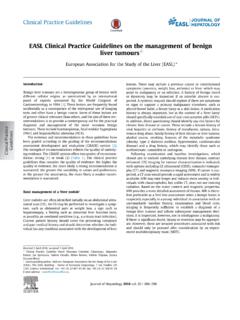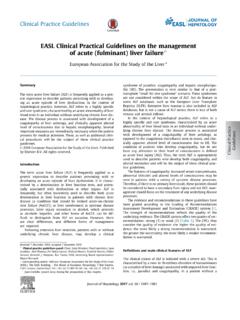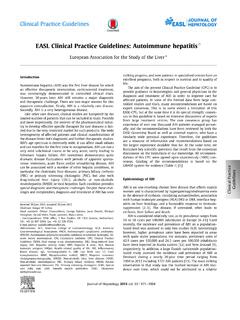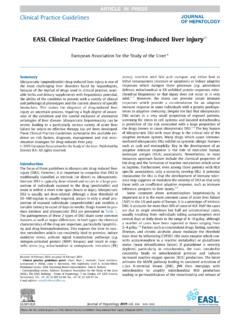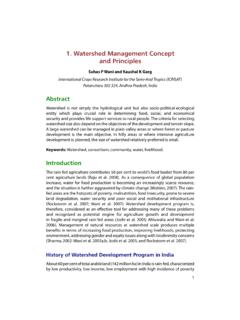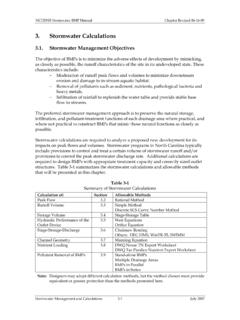Transcription of EASL Clinical Practice Guidelines for the management of ...
1 EASL Clinical Practice Guidelines for the management of patients withdecompensated cirrhosisqEuropean Association for the Study of the Liver SummaryThe natural history of cirrhosis is characterised by an asymp-tomatic compensated phase followed by a decompensatedphase, marked by the development of overt Clinical signs, themost frequent of which are ascites, bleeding, encephalopathy,and jaundice. The following Clinical Practice Guidelines (CPGs)represent the first CPGs on the management of decompensatedcirrhosis. In this context, the panel of experts, having empha-sised the importance of initiating aetiologic treatment for anydegree of hepatic disease at the earliest possible stage, extendedits work to all the complications of cirrhosis, which had notbeen covered by the European Association for the Study of theLiver Guidelines , namely.
2 Ascites, refractory ascites, hypona-tremia, gastrointestinal bleeding, bacterial infections, acute kid-ney injury, hepatorenal syndrome, acute-on-chronic liverfailure, relative adrenal failure, cirrhotic cardiomyopathy, hep-atopulmonary syndrome, and porto-pulmonary panel of experts, produced these GPGs using evidence fromPubMed and Cochrane database searches providing up to dateguidance on the management of decompensated cirrhosis withthe only purpose of improving Clinical Practice . 2018 European Association for the Study of the Liver. Published byElsevier All rights the panel of experts nominated by the European Associ-ation for the Study of the Liver (EASL) governing board beganwork to update the Clinical Practice Guidelines (CPGs) onascites, spontaneous bacterial peritonitis (SBP), and hepatorenalsyndrome (HRS),1it became obvious that all other complica-tions of decompensated cirrhosis had to be covered.
3 Within thisframework, a formal definition of decompensated cirrhosis wassought. The natural history of cirrhosis is characterised by asilent, asymptomatic course until increasing portal pressureand worsening liver function produce a Clinical phenotype. Inthe asymptomatic phase of the disease, usually referred to ascompensated cirrhosis, patients may have a good quality of life,and the disease may progress undetected for several is marked by the development of overt clinicalsigns, the most frequent of which are ascites, bleeding,encephalopathy, and jaundice. Following the first appearanceof any of these, the disease usually progresses more rapidlytowards death or liver transplantation (LT). This phase of thedisease has been designated decompensated cirrhosis.
4 2 Progression of the decompensated disease may be further accel-erated by the development of other complications such asrebleeding, acute kidney injury (AKI), with or without thefeatures of HRS, hepato-pulmonary syndrome (HPS), portopul-monary hypertension (PPHT), cirrhotic cardiomyopathy (CCM),and bacterial infections. Indeed, the development of bacterialinfections as well as hepatocellular carcinoma may acceleratethe course of the disease at any stage, but especially in decom-pensated defined the potential field of action,and having emphasised the importance of initiating aetiologictreatment for any degree of hepatic disease at the earliest pos-sible stage, the panel decided to extend the work to all thosecomplications of cirrhosis which have not yet been covered byEASL Guidelines , namely: gastrointestinal (GI) bleeding, bacte-rial infections other than SBP, acute-on-chronic liver failure(ACLF), adrenal failure, HPS, PPHT and CCM.
5 In doing so, we havehad to deal with the recommendations regularly proposed byvery well recognised international expert groups who haveworked in the field of GI bleeding or ascites and ascites-relatedcomplications for many years. Given their extreme importancein Clinical Practice , only specific aspects of their recommenda-tions were further developed in an attempt to give a more inte-grated view of the pathophysiology and management of patientswith decompensated cirrhosis. Thus, this document can no longerbe considered an update of earlier Guidelines , but rather the firstCPG on the management of decompensated cirrhosis with thesole purpose of improving Clinical development processA panel of hepatologists with a great interest in decompen-sated cirrhosis, approved by the EASL Governing Board, wroteand discussed this CPG between March 2017 and February2018.
6 The Guidelines were independently peer reviewed, andall contributors to the CPG disclosed their conflicts of interestby means of a disclosure form provided by the EASL Officeprior to work commencing. The EASL Ethics Committeereviewed the composition of the panel to eliminate thepotential for real or perceived bias. The CPG panel conflict ofinterests are declared in this submission. These Guidelines havebeen produced using evidence from PubMed and Cochranedatabase searches before 27 March 2018. Tables describingJournal of Hepatology2018vol. xxxjxxx xxxqClinical Practice Guideline Panel:Paolo Angeli (Chair), Mauro Bernardi(Governing Board representative), C ndid Villanueva, Claire Francoz, RajeshwarP. Mookerjee, Jonel Trebicka, Aleksander Krag, Wim Laleman, Pere Gines Corresponding author.
7 Address: European Association for the Study of the Liver(EASL), The EASL Building Home of Hepatology, 7 rue Daubin, CH 1203 Geneva,Switzerland. Tel.: +41 (0) 22 807 03 60; fax: +41 (0) 22 328 07 OF HEPATOLOGYC linical Practice GuidelinesPlease cite this article in press as: The European Association for the Study of the Liver. EASL Clinical Practice Guidelines for the management of patients with decompensated cirrhosis. JHepatol (2018), rationale behind the levels of evidence and of recommen-dations are provided (Table 1).Pathophysiology of decompensated cirrhosisThe transition from compensated asymptomatic cirrhosis todecompensated cirrhosis occurs at a rate of about 5% to 7% decompensation has occurred, cirrhosis becomes asystemic disease, with multi-organ/system thisstage, patients become highly susceptible to bacterial infectionsbecause of complex cirrhosis-associated immune dysfunction,which involves both innate and acquired turn,patients with bacterial infections are burdened by severe mor-bidity, up to ACLF, and high ,7 Because of these events,decompensation represents a prognostic watershed .
8 As the med-ian survival drops from more than 12 years for compensated cir-rhosis to about two years for decompensated the Clinical manifestations of decompensated cirrhosishave been seen as the consequence of a haemodynamic distur-bance, the hyperdynamic circulatory syndrome, ascribable toperipheral arterial vasodilation that mainly occurs in thesplanchnic circulatory area. The extent of such vasodilation isto endanger effective volaemia, ultimately leading to peripheralorgan hypoperfusion, the kidney being most ,reduced effective volaemia brings about the activation of vaso-constrictor and water and sodium retaining mechanisms, suchas the renin-angiotensin-aldosterone (RAAS), sympathetic ner-vous system and arginine-vasopressin secretion.
9 This explainssome of the cardinal features of decompensated cirrhosis, suchas renal retention of sodium and water leading to ascites forma-tion and HRS. Other manifestations attributable to haemody-namic abnormalities include HPS, increased susceptibility toshock, and a reduced cardiovascular responsiveness to physio-logical and pharmacological vasoconstrictor stimuli. Subsequentstudies have highlighted that a cardiac dysfunction, due to CCM,9is also involved in the pathogenesis of effective occurs particularly in the most advanced stages of decom-pensation, when such an abnormality prevents cardiac outputfrom increasing enough to comply with the needs of systemiccirculation. Although the molecular mechanisms responsiblefor arterial vasodilation, consisting of an enhanced endothelialproduction of vasodilating substances, such as nitric oxide, car-bon monoxide, prostacyclin and endocannabinoids have beenconvincingly demonstrated,11the primary causes of such abnor-malities remained somewhat obscure until it became clear thatpatients with advanced cirrhosis present a state of chronicinflammation, as witnessed by increased circulating levels ofpro-inflammatory cytokines and is likelycaused by the systemic spread of bacteria and bacterial products,called pathogen associated molecular patterns (PAMPs), as aresult of an abnormal bacterial translocation (BT).
10 Changes inthe microbiome and increased intestinal permeability accountfor this phenomenon. A similar role is likely played by othermolecules, called danger associated molecular patterns(DAMPs), released by the diseased liver because of local inflam-mation and cell apoptosis and necrosis. Both PAMPs and DAMP sbind with innate recognition receptors of immune cells that,once activated, produce and release pro-inflammatory mole-cules, along with reactive oxygen and nitrogen species. This cas-cade of events contributes to the development of circulatorydysfunction and, along with it, directly favours the developmentof multi-organ dysfunction and failure (Fig. 1).5 Current strate-gies for prophylaxis and treatment of decompensation and organfailure in cirrhosis rely on measures aimed to prevent or improvethe outcome of each complication, that is renal sodium retentionleading to ascites formation, ammonia production in hepaticencephalopathy, effective hypovolaemia after large-volumeparacentesis (LVP) or during HRS, renal dysfunction induced bySBP, and intestinal dysbiosis or bacterial overgrowth in patientspredisposed to develop infections.



